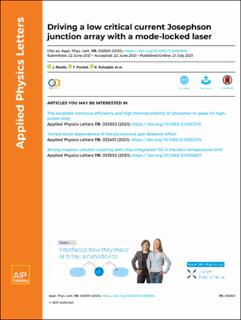| dc.identifier.citation | Nissilä, J., Fordell, T., Kohopää, K., Mykkänen, E., Immonen, P., Jabdaraghi, R. N., Bardalen, E., Kieler, O., Karlsen, B., Øhlckers, P. A., Behr, R., Manninen, A. J., Govenius, J. & Kemppinen, A. (2021). Driving a low critical current Josephson junction array with a mode-locked laser. Applied Physics Letters, 119(3), Artikkel 032601. | en_US |
| dc.description.abstract | We report proof-of-concept experiments on an optically driven Josephson voltage standard based on a mode-locked laser (MLL), a time-division multiplexer, and a cryogenic ultrafast photodiode driving an overdamped Josephson junction array (JJA). Our optical pulse pattern generator (PPG) concept builds on the capability of MLLs to produce trains of picosecond-wide optical pulses with little amplitude and temporal spread. Our present setup enables multiplication of the original 2.3 GHz pulse repetition frequency by a factor of 8. A commercial photodiode converts the optical pulses into about 25 ps wide electrical pulses in liquid helium several cm from the JJA. Using a custom-made MLL, we can drive a JJA with a low critical current of 360 μA at multiple Shapiro steps. We have performed experiments with pulse pairs whose time interval can be set freely without distorting the shapes of individual pulses. Experimental results are in qualitative agreement with theoretical simulations, and they demonstrate, e.g., crossover in the Shapiro step pattern when the time interval between the pulses is approximately equal to the inverse of the characteristic frequency of the JJA. However, there are quantitative discrepancies, which motivate an improved integration of photodiodes and JJAs to improve both the understanding and fidelity of Josephson Arbitrary Waveform Synthesizers. Considering future quantum technologies in a wider perspective, our optical approach is a potential enabler for fast and energy-efficient pulse drive without an expensive high-bandwidth electrical PPG and without high-bandwidth electrical cables that yield too high thermal conductance between cryogenic and room temperatures. | en_US |

